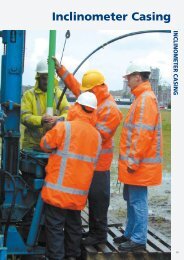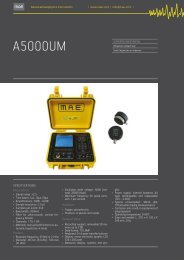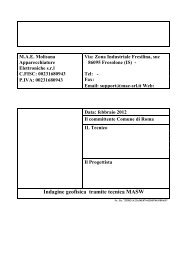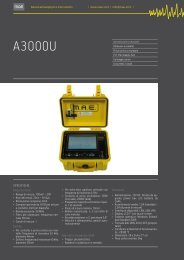Untitled
Untitled
Untitled
Create successful ePaper yourself
Turn your PDF publications into a flip-book with our unique Google optimized e-Paper software.
› Geo-Electric Explorations<br />
48<br />
› INDUCED POLARISATION<br />
The Induced Polarisation (PI) is an<br />
electric phenomenon that occurs inside<br />
of material media in the time domain,<br />
with the release of stresses upon<br />
the interruption of a flow of electric<br />
current of step type (in this case, it is<br />
measured as chargeability) and also in<br />
the frequency domain, with a precise<br />
dispersion law of the electric resistivity<br />
upon the variation of the frequency<br />
of an alternated current flow. A PI<br />
source is connected to the oxido-reductive<br />
processes along the interface<br />
between the metal grains and interstitial<br />
fluids (electrode polarisation). Another<br />
important PI source consists instead<br />
of ionic accumulations in moving<br />
electrolytes due to mobility variations<br />
along the path (electro-kinetic polarisation).<br />
The tomographic inversion of<br />
the data obtained on the surface returns<br />
the ground in “output” based on<br />
chargeability images, thanks to which<br />
it is possible to identify possible accumulation<br />
areas or significant concentrations<br />
of hydrocarbons. The chargeability<br />
is proportional to the charge<br />
stored by the lithotype and it represents<br />
the concentration of a conductor<br />
in the multi-electrode area.<br />
› SPONTANEOUS-POTENTIAL METHOD<br />
The Spontaneous Potential method<br />
(PS) consists in determining on<br />
the surface, the differences of potential<br />
related to a natural electric<br />
field, linked to the underground circulation<br />
of aqueous electrolytic solutions<br />
in porous media. From the analysis<br />
of PS anomalies in the surface, it<br />
is possible to determine the intensity<br />
and position of the concentrations<br />
of ionic charges with both polarities.<br />
The test is carried out by positioning<br />
two electrodes: the first one close to<br />
the measurement station and the other<br />
one is moved on the following stations<br />
of the line; of both electrodes<br />
are moved, by keeping stable the interval<br />
between them, mapping the<br />
ground based on the spontaneous potential.<br />
The use of this method is useful<br />
in the mining field for the search<br />
of sulphides and graphite, but also in<br />
the archaeological field, indeed water<br />
circulations can be affected by underground<br />
archaeological structures,<br />
that could act as drain or as obstacle,<br />
and therefore, with the identification<br />
of PS anomalies, it is possible in general<br />
to find underground archaeological<br />
structures indirectly.









